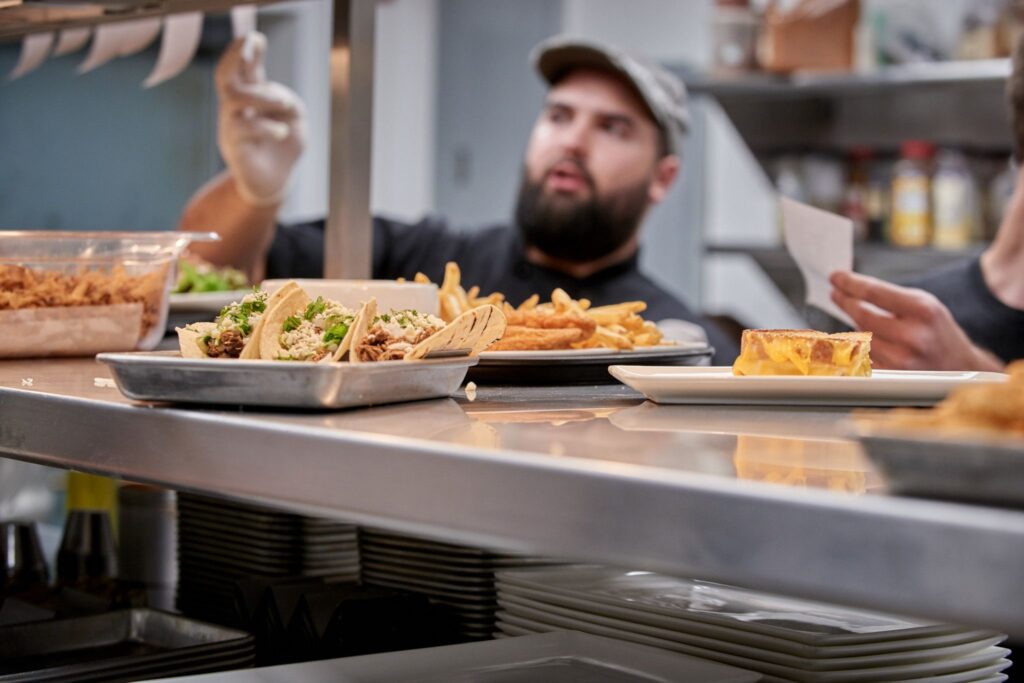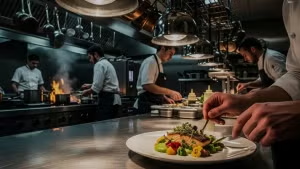World Food Safety Day, observed on June 7th, supports the World Health Organization’s efforts to raise awareness about the importance of food safety in preventing, detecting, and managing foodborne risks.
While one in ten people worldwide gets sick from contaminated food each year, World Food Safety Day is a global reminder to follow food safety best practices so everyone is safe from foodborne illnesses.1
You can take simple steps to address food safety in your kitchen. One of the easiest ways is to pay attention to your cooking methods and to follow set cleaning routines.
In this post, we’ll explore the “kitchen chemistry” behind food safety and show you the importance of your role in keeping everyone safe.
Do Different Cooking Methods Affect Food Safety?
Cooking isn’t just about creating delicious meals; it’s fundamentally about ensuring the food you’re preparing is safe.
You and your team may use several cooking methods, including dry heat cooking (baking, grilling, and frying), moist heat cooking (boiling, steaming, or poaching), and methods that combine dry and moist heat techniques (like braising and stewing).
Did you know each cooking method has different risks of foodborne illness? However, the real risk isn’t in the cooking method but in not cooking the food enough.
- Baking: This method uses hot air to cook food, which helps kill harmful bacteria and pathogens present in the food.
- Grilling: Grilling exposes food to high heat, which can eliminate contaminants on the surface of the food, enhancing food safety.
- Frying: Frying at high temperatures can destroy bacteria, but it’s important to monitor oil temperature to prevent overheating and the production of harmful compounds.
- Boiling: Boiling food in water at high temperatures effectively kills most bacteria and parasites, making it a safe cooking method.
- Steaming: Steaming food helps retain nutrients while ensuring thorough cooking and killing potential pathogens.
- Poaching: Cooking food in simmering liquid gently and evenly can maintain food safety by eliminating harmful microorganisms.
- Braising: This method involves searing food at high heat and simmering it in a liquid, ensuring it is cooked thoroughly and safely.
- Stewing: Stewing combines moist-heat cooking with long, slow cooking times, effectively killing bacteria and other contaminants in the food.
When done correctly, all cooking methods can help reduce the risk of foodborne illness by killing harmful bacteria and pathogens. However, some methods may pose a slightly greater risk if done incorrectly.
What Influences the Spread of Foodborne Illnesses?
Understanding the pathogens that can cause foodborne illnesses is important for effectively managing food safety. They include:
- Bacteria: Examples include Salmonella, E. Coli, and Listeria. These bacteria can be found in raw poultry, undercooked ground beef, and unpasteurized milk.
- Viruses: Norovirus and Hepatitis A are common culprits. These viruses can spread through contaminated food and surfaces.
- Parasites: Trichinella and Giardia can also cause foodborne illnesses. Parasites are often found in undercooked meat and contaminated water.
Let’s look at how different cooking methods and cross-contamination influence the spread of these pathogens and the illnesses they cause.
Cooking Temperatures
Keeping food out of the temperature danger zone should be a top priority when preparing food. When TCS, or Time/Temperature Control for Safety, foods are in the temperature danger zone for too long, bacteria can double in number every twenty minutes, dramatically increasing the risk of foodborne illnesses.
Proper food storage before and after cooking goes a long way toward keeping food out of the danger zone, but there are also inherent risks involved in the cooking process.
For example, techniques like slow cooking, braising, or stewing involve cooking food at lower temperatures over an extended period. While these methods can yield delicious results, they may allow food to linger in the temperature danger zone if not monitored carefully.
Sous vide cooking, which involves vacuum-sealing food and cooking it in a water bath at precise temperatures for an extended period, is only safe if done correctly. However, maintaining consistent water bath temperatures and following recommended cooking times are essential to prevent the growth of harmful bacteria.
Similarly, settings like buffets or potlucks where food sits out for extended periods can also pose risks. Prepared hot foods, salads, deli meats, and dairy-based dishes should not be left at room temperature and must have some time or temperature controls to protect them.
While grilling and barbecuing are popular cooking methods that impart delicious flavors, they can sometimes lead to uneven cooking. If meats are charred on the outside but undercooked inside, there is a risk of bacterial contamination.
Food-Specific Temperature Guidelines
Ensuring food reaches the proper internal temperature is critical regardless of your chosen cooking method. A food thermometer can help you achieve and maintain proper cooking temperatures throughout preparation.
Food’s internal temperature is particularly important for cooking methods that don’t necessarily cook food evenly (like grilling, as mentioned earlier). You should never just “eyeball” food; measure the temperature before serving it.
Chicken and turkey must be cooked to a minimum temperature of 165°F (74°C). For ground beef, it’s 160°F (71°C) and 120° to 160°F (71°C) for steaks and roasts (120°F represents the absolute lowest you should go and would result in a rare presentation).
Pork should be cooked to 14 °F (63°C), with ground pork at 160°F, while fish and shellfish need to be 145°F (63°C).
Remember, you must cook foods to these temperatures regardless of the cooking method.
Cross-Contamination
Cross-contamination is a significant risk regardless of the cooking method, though again, certain methods tend to present different risks.
For example, cooking methods like grilling, where utensils and surfaces come into direct contact with raw meat, can increase the risk of cross-contamination if you and your team do not follow proper hygiene practices.
An easy way to avoid cross-contamination is to use different cutting boards and utensils for raw and cooked foods—for example, reserve one cutting board for raw meats and another for vegetables. Use one spatula to flip uncooked burgers on the grill and another to remove the finished product.
Limiting Reactions: Tips for Proper Food Preparation
Outside of paying attention to the cooking method, there are universal precautions you should be taking to keep your food safe in the preparation process. Here’s an overview.
1. Follow Proper Hand Hygiene
Food preparation is a delicate dance of flavors, textures, and temperatures, but bacteria shouldn’t be invited to the party.
Always wash your hands thoroughly with soap and water before and after handling any food, touching raw ingredients like meat or eggs, and using the restroom.
Handwashing is hands down (pun intended) the best way to prevent foodborne illness.
2. Preheat the Slow Cooker
If you plan on using a slow cooker for your kitchen prep, it’s important to preheat the appliance ahead of time. It takes a while for the slow cooker to reach safe, bacteria-killing temperatures.
You also must always thaw meat ahead of time. A slow cooker will expose raw, frozen meat to unsafe temperatures for too long.4
3. Wear Gloves and Other PPE
Wearing gloves and other personal protective equipment (PPE) can also help prevent contamination. Gloves provide a barrier between hands and food, reducing the risk of transferring harmful microorganisms.
You’ll need to remember to change gloves frequently, especially when switching tasks or handling different ingredients.
4. Avoid Cross Contamination
As mentioned earlier, cross-contamination is a significant concern in the kitchen and can occur when harmful bacteria from raw foods come into contact with ready-to-eat items. To prevent cross-contamination, always:
- Use separate cutting boards and utensils for raw meats and cooked foods.
- Clean and sanitize surfaces, knives, and other tools after they come into contact with raw ingredients.
- Store raw meats on the bottom shelf of the refrigerator to prevent drips onto other foods.
5. Choose Safe Suppliers
While you can do everything in your power to ensure food safety in your kitchen, it’s not worth much if the food is already contaminated and unsafe when it arrives.
That’s why it’s essential to work with a trusted supplier who demonstrates the same level of commitment to food safety as you. Look for a supplier who stores its products correctly and strictly follows food safety regulations.
6. Properly Thaw and Store Ingredients
Thawing ingredients safely is another critical step in preventing bacterial growth and ensuring food remains safe. Thaw frozen foods in the refrigerator, under cold running water, or in the microwave. Avoid leaving them at room temperature, where bacteria can multiply rapidly.
Always store perishable ingredients at the appropriate temperatures to maintain their freshness and reduce the risk of spoilage.
Scrubbing Away Risks: The Power of Your Cleaning Practices
While most food contamination with pathogens occurs before cooking, there’s a lot you can do once the kitchen is closed to help prevent the future spread of foodborne illnesses, too.
1. Cleaning vs. Sanitizing
A clean kitchen is a safe kitchen! Cleaning involves removing visible dirt, debris, and organic matter from surfaces, reducing the number of microorganisms on these surfaces. It should be the first step before sanitization.
Sanitizing, on the other hand, refers to reducing the number of microorganisms on surfaces to a safe level. After cleaning, you should use sanitizing agents to kill harmful bacteria and pathogens.
Both are important when it comes to preventing the spread of foodborne illnesses. Here are some tips:
- Use hot, soapy water to clean surfaces, utensils, and equipment.
- Rinse thoroughly with clean water to remove soap residue.
- Apply a sanitizer per manufacturer instructions, or use a bleach solution for disinfection.
- Allow surfaces to air dry or use disposable towels to prevent decontamination.
2. Storing and Handling Leftovers
Refrigerate leftovers promptly within two hours of cooking. When you reheat those leftovers, ensure they reach an internal temperature of 165°F (74°C) to kill pathogens.
Also, label leftovers with the date of preparation and ensure you use them within three to four days, depending on the type of food.
3. Mind That Fryer
Frying can elevate dishes to new heights, but improper frying poses risks. One of the most valuable things you can do when cleaning up at the end of your shift is to ensure the fryer is as clean as possible.
A daily scrub-down is essential, and your team should also perform a deep clean once a month or so (or whenever you change out your spent oil).
Reusing oil too much can lead to the accumulation of harmful compounds and promote bacterial growth. Because of this, to maintain food safety standards, you need to monitor oil quality, filter it regularly, and replace it when necessary.
Understand the Science and Master the Art of Food Safety
Food safety matters to everyone, and we all play a role in promoting it. This World Safety Day, celebrate by taking action.
The best way to commit to food safety is to invest in the right training for you and your team (like Trust20’s online courses and certification exam).
No matter your role, understanding how food safety fits into the cooking process will help you protect your customers from foodborne illnesses while you create exceptional food experiences.
In a world where food brings us together and nourishes our bodies and souls, let’s pledge to make food safety a cornerstone of our kitchen practices. Happy World Food Safety Day!
Sources:
1. World Health Organization: World Food Safety Day 2024
2. BBC News: The hidden risks of cooking your food
3. WebMD: What Is Sous Vide Cooking?
4. USDA: Slow Cookers and Food Safety











